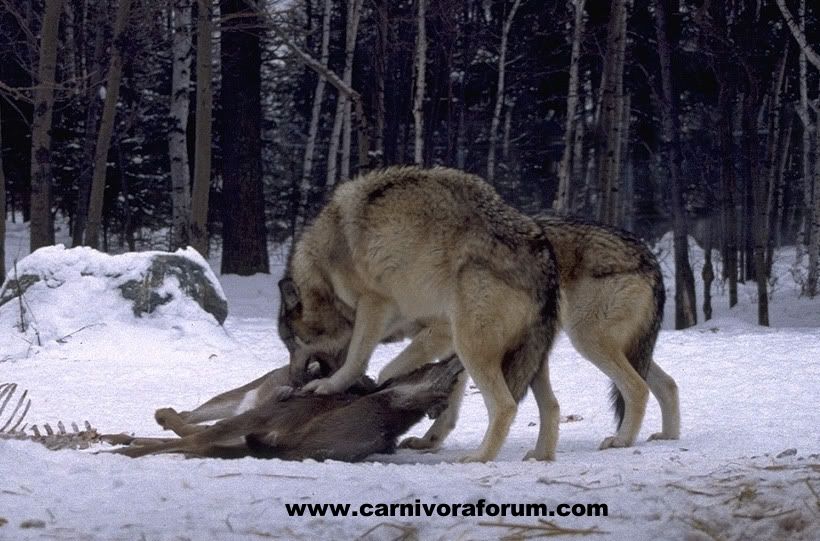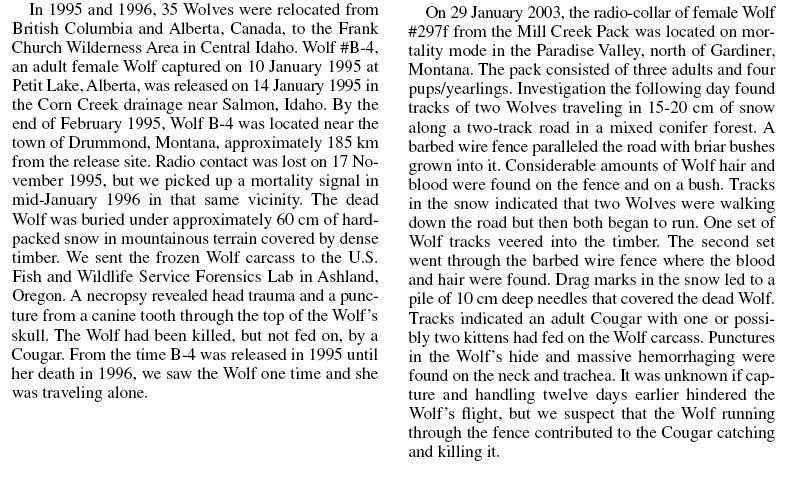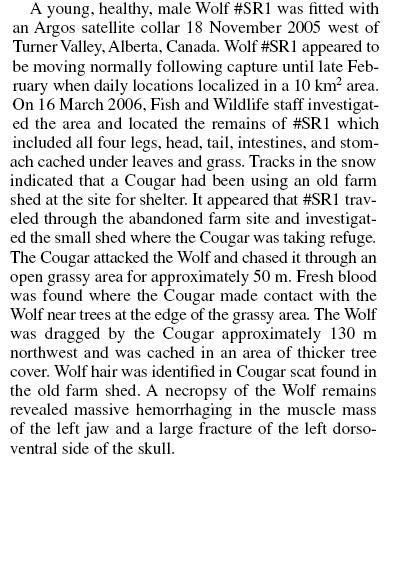Post by Runic on Sept 23, 2013 22:33:27 GMT 5
Grey Wolf

The grey wolf or gray wolf (Canis lupus), also known as simply wolf, is the largest wild member of the Canidae family. It is an ice age survivor originating during the Late Pleistocene around 300,000 years ago. DNA sequencing and genetic drift studies reaffirm that the gray wolf shares a common ancestry with the domestic dog (Canis lupus familiaris). Although certain aspects of this conclusion have been questioned, including recently, the main body of evidence confirms it. A number of other gray wolf subspecies have been identified, though the actual number of subspecies is still open to discussion. Gray wolves are typically apex predators in the ecosystems they occupy. Though not as adaptable as more generalist canid species, wolves have thrived in temperate forests, deserts, mountains, tundra, taiga, grasslands, and even urban areas.
Distribution
Though once abundant over much of Eurasia and North America, the gray wolf inhabits a very small portion of its former range because of widespread destruction of its territory, human encroachment, and the resulting human-wolf encounters that sparked broad extirpation. Even so, the gray wolf is regarded as being of least concern for extinction according to the International Union for Conservation of Nature, when the entire gray wolf population is considered as a whole. Today, wolves are protected in some areas, hunted for sport in others, or may be subject to extermination as perceived threats to livestock and pets.
Physical characteristics
Gray wolf weight and size can vary greatly worldwide, tending to increase proportionally with latitude as predicted by Bergmann's Rule. In general, height varies from 0.6 to .95 meters and (26–38 inches) at the shoulder. Wolf weight varies geographically; on average, European wolves may weigh 38.5 kg (85 lbs), North American wolves 80 lbs - 130lbs, and Indian and Arabian wolves 25 kg (55 lbs). Though rarely encountered, extreme specimens of more than 77 kg (170 lb.) have been recorded in Alaska, Canada, and the former Soviet Union. The heaviest recorded gray wolf in the New World was killed on 70 Mile River in east-central Alaska on July 12, 1939 and weighed 79 kg (175 lb.), while the heaviest recorded wolf in the Old World was killed after World War II in the Kobelyakski Area of the Poltavskij Region in the Ukrainian SSR, and weighed 86 kg (189 lb.). Grey wolves are sexually dimorphic, with females in any given wolf population typically weighing 20% less than males. Females also have narrower muzzles and foreheads; slightly shorter, smoother furred legs; and less massive shoulders. Gray wolves can measure anywhere from 1.3 to 2 meters (4.5–6.5 feet) from nose to the tip of the tail, which itself accounts for approximately one quarter of overall body length.
Gray wolves rely on their stamina rather than speed for hunting. Their narrow chests and powerful backs and legs facilitate efficient locomotion. They are capable of covering several miles trotting at about a pace of 10 km/h (6 mph), and have been known to reach speeds approaching 65 km/h (40 mph) during a chase. One female gray wolf was recorded to have made 7 metre bounds when chasing prey.
Gray wolf paws are able to tread easily on a wide variety of terrains, especially snow. There is a slight webbing between each toe, which allows them to move over snow more easily than comparatively hampered prey. Gray wolves are digitigrade, which, with the relative largeness of their feet, helps them to distribute their weight well on snowy surfaces. The front paws are larger than the hind paws, and have a fifth digit, the dewclaw, that is absent on hind paws. Bristled hairs and blunt claws enhance grip on slippery surfaces, and special blood vessels keep paw pads from freezing. Scent glands located between a wolf's toes leave trace chemical markers behind, helping the wolf to effectively navigate over large expanses while concurrently keeping others informed of its whereabouts. Unlike dogs and western coyotes, gray wolves have a lower density of sweat glands on their paws. This trait is also present in Eastern Canadian Coyotes which have been shown to have recent wolf ancestry. Wolves in Israel are unique due to the middle two toes of their paws being fused, a trait originally thought to be unique to the African Wild Dog.
At birth, wolf pups tend to have darker fur and blue irises that will change to a yellow-gold or orange color when the pups are between 8 and 16 weeks old.
Cougar

Physical Characteristics - Size
In terms of length & weight the cougar is the fourth largest member of the feline family (after the tiger, lion & jaguar).
In terms of length they vary between about 7 - 10 foot, head to tip of tail.
Weight varies too depending on sex & subspecies. The largest subspecies are Puma concolor cougar & Puma concolor puma - the most northerly & southerly subspecies. The smallest subspecies is Puma concolor concolor.
Size is not determined by Bergmanns Rule, but rather prey size & availabilty.
Puma Concolor Cougar - Male - average weight 150 - 160 pounds, Females 100 - 120 pounds.
Most males don't exceed 200 pounds, but some do. The largest ever cougar killed was a 276 pound male in Arizona.
Colour - ThecougarÂ’s normal colour is reddish tawny or tawny grey to dark chocolate brown. The backs of the ears and the tip of the tail are black, and there are black markings on the face. The kittens are spotted at birth, but the spots disappear before the end of their first year.
There has been reports of 'black' cougars in Sth America, but I've seen little evidence to support this.
The cougar has the long powerful limbs - in fact proportionally the longest hind legs to weight in the feline family. Paws too are proportionally large. Cougars have five digits on the forepaw and four on the hindpaw. Each digit is equipped with a claw, which the cougar sheathes while walking, but which it uses with deadly effectiveness when grasping its prey. The front feet and claws are larger than their counterparts in the rear, again adaptations for clutching large prey.
The Cougar's tail makes up about a third of the total length of its body and serves to improve balance.
Skull, Jaws and teeth
Head size relative to pantherine cats is smaller, and varies between the sexes. Males have larger heads than females. In terms of skull growth, female skulls stop developing after 2 years of age, whereas the male cougars skull continues the grow up to 6 years of age.
Compared to canids, the rostrum of cougars is short and occipital orbits are large . The shortened rostrum allows for a more powerful bite but reduces a cougars smelling ability; however the larger occipital orbit increases their vision, the sense which they rely on the most.
The cougar has muscular jaws, a wide gape, and long canine teeth are designed for clamping down on and holding onto prey larger than itself. The cougar has, in addition, teeth that are specially adapted for cutting meat, tendons, and sinews.
" Puma’s also have a remarkable array of 28 teeth, eight of which are especially crucial for hunting. “The four long canines are for puncturing and gripping, and the four carnassials at the rear snip the meat into pieces”
In terms of canine length an adults cougars canines vary in length between 1 1/2 - 2 inches, with Sth American cougars having longer canines proportionally to Nth American cougars.
Read more: theworldofanimals.proboards.com/thread/97/cougar-mountain-lion-puma-concolor#ixzz2fjpmxjtx

The grey wolf or gray wolf (Canis lupus), also known as simply wolf, is the largest wild member of the Canidae family. It is an ice age survivor originating during the Late Pleistocene around 300,000 years ago. DNA sequencing and genetic drift studies reaffirm that the gray wolf shares a common ancestry with the domestic dog (Canis lupus familiaris). Although certain aspects of this conclusion have been questioned, including recently, the main body of evidence confirms it. A number of other gray wolf subspecies have been identified, though the actual number of subspecies is still open to discussion. Gray wolves are typically apex predators in the ecosystems they occupy. Though not as adaptable as more generalist canid species, wolves have thrived in temperate forests, deserts, mountains, tundra, taiga, grasslands, and even urban areas.
Distribution
Though once abundant over much of Eurasia and North America, the gray wolf inhabits a very small portion of its former range because of widespread destruction of its territory, human encroachment, and the resulting human-wolf encounters that sparked broad extirpation. Even so, the gray wolf is regarded as being of least concern for extinction according to the International Union for Conservation of Nature, when the entire gray wolf population is considered as a whole. Today, wolves are protected in some areas, hunted for sport in others, or may be subject to extermination as perceived threats to livestock and pets.
Physical characteristics
Gray wolf weight and size can vary greatly worldwide, tending to increase proportionally with latitude as predicted by Bergmann's Rule. In general, height varies from 0.6 to .95 meters and (26–38 inches) at the shoulder. Wolf weight varies geographically; on average, European wolves may weigh 38.5 kg (85 lbs), North American wolves 80 lbs - 130lbs, and Indian and Arabian wolves 25 kg (55 lbs). Though rarely encountered, extreme specimens of more than 77 kg (170 lb.) have been recorded in Alaska, Canada, and the former Soviet Union. The heaviest recorded gray wolf in the New World was killed on 70 Mile River in east-central Alaska on July 12, 1939 and weighed 79 kg (175 lb.), while the heaviest recorded wolf in the Old World was killed after World War II in the Kobelyakski Area of the Poltavskij Region in the Ukrainian SSR, and weighed 86 kg (189 lb.). Grey wolves are sexually dimorphic, with females in any given wolf population typically weighing 20% less than males. Females also have narrower muzzles and foreheads; slightly shorter, smoother furred legs; and less massive shoulders. Gray wolves can measure anywhere from 1.3 to 2 meters (4.5–6.5 feet) from nose to the tip of the tail, which itself accounts for approximately one quarter of overall body length.
Gray wolves rely on their stamina rather than speed for hunting. Their narrow chests and powerful backs and legs facilitate efficient locomotion. They are capable of covering several miles trotting at about a pace of 10 km/h (6 mph), and have been known to reach speeds approaching 65 km/h (40 mph) during a chase. One female gray wolf was recorded to have made 7 metre bounds when chasing prey.
Gray wolf paws are able to tread easily on a wide variety of terrains, especially snow. There is a slight webbing between each toe, which allows them to move over snow more easily than comparatively hampered prey. Gray wolves are digitigrade, which, with the relative largeness of their feet, helps them to distribute their weight well on snowy surfaces. The front paws are larger than the hind paws, and have a fifth digit, the dewclaw, that is absent on hind paws. Bristled hairs and blunt claws enhance grip on slippery surfaces, and special blood vessels keep paw pads from freezing. Scent glands located between a wolf's toes leave trace chemical markers behind, helping the wolf to effectively navigate over large expanses while concurrently keeping others informed of its whereabouts. Unlike dogs and western coyotes, gray wolves have a lower density of sweat glands on their paws. This trait is also present in Eastern Canadian Coyotes which have been shown to have recent wolf ancestry. Wolves in Israel are unique due to the middle two toes of their paws being fused, a trait originally thought to be unique to the African Wild Dog.
At birth, wolf pups tend to have darker fur and blue irises that will change to a yellow-gold or orange color when the pups are between 8 and 16 weeks old.
Cougar

Physical Characteristics - Size
In terms of length & weight the cougar is the fourth largest member of the feline family (after the tiger, lion & jaguar).
In terms of length they vary between about 7 - 10 foot, head to tip of tail.
Weight varies too depending on sex & subspecies. The largest subspecies are Puma concolor cougar & Puma concolor puma - the most northerly & southerly subspecies. The smallest subspecies is Puma concolor concolor.
Size is not determined by Bergmanns Rule, but rather prey size & availabilty.
Puma Concolor Cougar - Male - average weight 150 - 160 pounds, Females 100 - 120 pounds.
Most males don't exceed 200 pounds, but some do. The largest ever cougar killed was a 276 pound male in Arizona.
Colour - ThecougarÂ’s normal colour is reddish tawny or tawny grey to dark chocolate brown. The backs of the ears and the tip of the tail are black, and there are black markings on the face. The kittens are spotted at birth, but the spots disappear before the end of their first year.
There has been reports of 'black' cougars in Sth America, but I've seen little evidence to support this.
The cougar has the long powerful limbs - in fact proportionally the longest hind legs to weight in the feline family. Paws too are proportionally large. Cougars have five digits on the forepaw and four on the hindpaw. Each digit is equipped with a claw, which the cougar sheathes while walking, but which it uses with deadly effectiveness when grasping its prey. The front feet and claws are larger than their counterparts in the rear, again adaptations for clutching large prey.
The Cougar's tail makes up about a third of the total length of its body and serves to improve balance.
Skull, Jaws and teeth
Head size relative to pantherine cats is smaller, and varies between the sexes. Males have larger heads than females. In terms of skull growth, female skulls stop developing after 2 years of age, whereas the male cougars skull continues the grow up to 6 years of age.
Compared to canids, the rostrum of cougars is short and occipital orbits are large . The shortened rostrum allows for a more powerful bite but reduces a cougars smelling ability; however the larger occipital orbit increases their vision, the sense which they rely on the most.
The cougar has muscular jaws, a wide gape, and long canine teeth are designed for clamping down on and holding onto prey larger than itself. The cougar has, in addition, teeth that are specially adapted for cutting meat, tendons, and sinews.
" Puma’s also have a remarkable array of 28 teeth, eight of which are especially crucial for hunting. “The four long canines are for puncturing and gripping, and the four carnassials at the rear snip the meat into pieces”
In terms of canine length an adults cougars canines vary in length between 1 1/2 - 2 inches, with Sth American cougars having longer canines proportionally to Nth American cougars.
Read more: theworldofanimals.proboards.com/thread/97/cougar-mountain-lion-puma-concolor#ixzz2fjpmxjtx
















